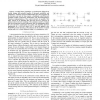Free Online Productivity Tools
i2Speak
i2Symbol
i2OCR
iTex2Img
iWeb2Print
iWeb2Shot
i2Type
iPdf2Split
iPdf2Merge
i2Bopomofo
i2Arabic
i2Style
i2Image
i2PDF
iLatex2Rtf
Sci2ools
DATE
2010
IEEE
2010
IEEE
Control network generator for latency insensitive designs
—Creating latency insensitive or asynchronous designs from clocked designs has potential benefits of increased modularity and robustness to variations. Several transformations have been suggested in the literature and each of these require a handshake control network (examples include synchronous elasticization and desynchronization). Numerous implementations of the control network are possible. This paper reports on an algorithm that has been proven to generate an optimal control network consisting of the minimum number of 2-input join and 2-output fork control components. This can substantially reduce the area and power consumption of a system. The algorithm has been implemented in a CAD tool, called CNG. It has been applied to the MiniMIPS processor showing a 14% reduction in the number of control steering units over a hand optimized design in a contemporary work.
| Added | 10 Jul 2010 |
| Updated | 10 Jul 2010 |
| Type | Conference |
| Year | 2010 |
| Where | DATE |
| Authors | Eliyah Kilada, Kenneth S. Stevens |
Comments (0)

